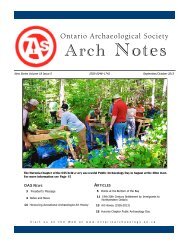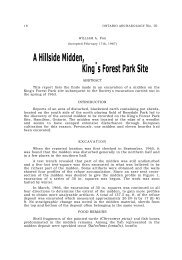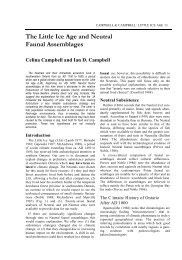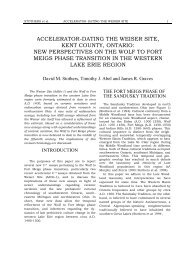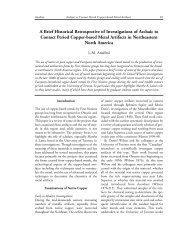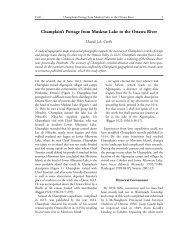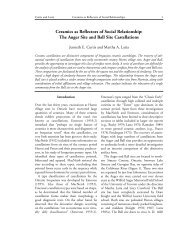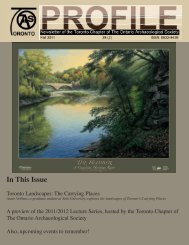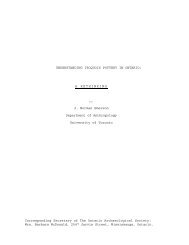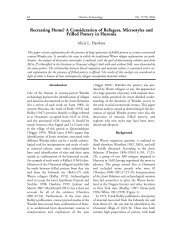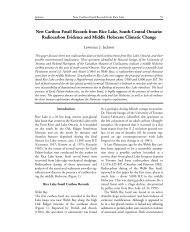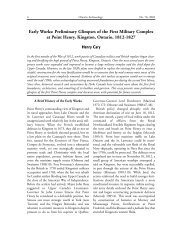Huron-St. Lawrence Iroquois Relations in the Terminal Prehistoric ...
Huron-St. Lawrence Iroquois Relations in the Terminal Prehistoric ...
Huron-St. Lawrence Iroquois Relations in the Terminal Prehistoric ...
You also want an ePaper? Increase the reach of your titles
YUMPU automatically turns print PDFs into web optimized ePapers that Google loves.
24 ONTARIO ARCHAEOLOGY NO. 44auspices of <strong>the</strong> New York Historical Society and<strong>the</strong> Smithsonian Institution. He published <strong>the</strong>results of this survey twice, first with <strong>the</strong> SmithsonianInstitution <strong>the</strong>n commercially <strong>in</strong> Buffalo(Squire 1851a:17-26; 1851b). In 1850 and aga<strong>in</strong> <strong>in</strong>1851 Frankl<strong>in</strong> B. Hough published short papers <strong>in</strong>which he noted <strong>the</strong> locations and nature of sites <strong>in</strong>Jefferson County and described some pottery andpipes from <strong>the</strong>se sites (Hough 1850:100-105;1851:103-109). In 1854 Hough re-published muchof this <strong>in</strong>formation <strong>in</strong> his History of JeffersonCounty (1854:10-13). The Jefferson CountyHistorical Society published a booklet <strong>in</strong> 1895which <strong>in</strong>cludes a paper by Henry Woodworth thatnotes <strong>the</strong> presence of archaeological sites <strong>in</strong> generalterms. In 1898 Edgar C. Emerson published hiswork on Jefferson County <strong>in</strong> which he noted <strong>the</strong>location of many archaeological sites us<strong>in</strong>g a seriesof sketch maps. In 1900 William M. Beauchamppublished an <strong>in</strong>ventory of <strong>the</strong> archaeological sites<strong>in</strong> <strong>the</strong> County.But it was not until 1906, when a PeabodyMuseum field party under M.R. Harr<strong>in</strong>gton excavatedon fourteen <strong>Iroquois</strong> sites, that a record of<strong>the</strong> <strong>Iroquois</strong> material culture from Jefferson Countybecame available. Harr<strong>in</strong>gton reported on thirteenof <strong>the</strong>se sites <strong>in</strong> his paper <strong>Prehistoric</strong> <strong>Iroquois</strong> Sites<strong>in</strong> Nor<strong>the</strong>rn New York (1922) but a more detailedaccount of his work on <strong>the</strong> Putnam site rema<strong>in</strong>sunpublished (Harr<strong>in</strong>gton n.d.). In 1922 Arthur C.Parker published a catalogue of archaeological sites<strong>in</strong> New York <strong>St</strong>ate which <strong>in</strong>cludes those <strong>in</strong>Jefferson County. This work was largely derivedfrom Beauchamp's earlier <strong>in</strong>ventory. William A.Ritchie visited <strong>Iroquois</strong> sites <strong>in</strong> Jefferson Countybut he did not publish an account of his work <strong>the</strong>re(Funk 1977).In 1966 Robert Weber, a graduate student at <strong>the</strong><strong>St</strong>ate University of New York at Buffalo(SUNYAB) surveyed <strong>the</strong> Sandy Creek dra<strong>in</strong>ageand <strong>the</strong> Watertown area. He succeeded <strong>in</strong> locat<strong>in</strong>gseventeen of <strong>the</strong> sites recorded <strong>in</strong> <strong>the</strong> early literature(Weber 1968; White n.d.a:l).In 1967 a Highway Salvage Survey Team fromSUNYAB surveyed areas <strong>in</strong> Jefferson County and<strong>the</strong> Durham site <strong>in</strong> particular. In part due to <strong>the</strong>success of this work, Marian White formulated aresearch proposal entitled "The Nature of Warfareand Confederacies among <strong>the</strong> Nor<strong>the</strong>rn <strong>Iroquois</strong>"and <strong>in</strong> 1968 conducted <strong>the</strong> SUNYAB SummerSchool which located some twenty sites <strong>in</strong> <strong>the</strong>Sandy Creek dra<strong>in</strong>age. Excavations were conductedon eight sites <strong>in</strong>clud<strong>in</strong>g <strong>the</strong> Durham siteaga<strong>in</strong>. In 1969 <strong>the</strong> SUNYAB Summer Field Schoolundertook a major excavation on <strong>the</strong> Durham site(Sidler 1971). Plans to cont<strong>in</strong>ue work by SUNYAB<strong>in</strong> Jefferson County were term<strong>in</strong>ated by Dr. White'suntimely death.Over <strong>the</strong> past decade excavations have been conductedon a number of <strong>St</strong>. <strong>Lawrence</strong> <strong>Iroquois</strong> sites<strong>in</strong> Jefferson County. Marjorie Burger and PeterPratt have excavated on <strong>the</strong> Camp Drum 1 site;Peter Miller of SUNY at Potsdam on <strong>the</strong> Depauvillesite and <strong>the</strong> late Merill Waters of Water-town, NewYork on <strong>the</strong> Frank site near Dexter. Earl Sidlerconducted a field school on <strong>the</strong> Carlos site and on<strong>the</strong> Morse site. He also excavated on <strong>the</strong> Potockisite. Accounts of this work have not beenpublished.The long and varied history of <strong>Iroquois</strong> archaeologicalsites <strong>in</strong> Jefferson County is characterized by<strong>the</strong>ir hav<strong>in</strong>g been ravaged by collectors from farand wide. Large collections remarked upon <strong>in</strong> <strong>the</strong>19th century for <strong>the</strong>ir sophisticated artifacts can nolonger be located. Tales of collectors who saved onlypipes and those who only saved reconstructedpottery rims are still recounted. Apart from <strong>the</strong> JackCarter collection at Clayton, <strong>the</strong> Merill Waters collection<strong>in</strong> Watertown and a few o<strong>the</strong>rs which providereliable provenance, no private collectionshave survived for study.The literature suggests <strong>the</strong>re were some sixty-odd<strong>Iroquois</strong> sites <strong>in</strong> <strong>the</strong> County, nearly double that <strong>in</strong>nearby Ontario and Quebec. However this estimateshould be noted with reservations. There has notbeen a comprehensive archaeological survey of <strong>the</strong>County and current site list<strong>in</strong>gs are flawed by <strong>the</strong>many names by which some sites have been knownover <strong>the</strong> years. The earlier Algonqu<strong>in</strong>-<strong>Iroquois</strong>dichotomy by which sites <strong>in</strong> <strong>the</strong> County wereclassified also cont<strong>in</strong>ues to conceal some early<strong>Iroquois</strong> sites.European MaterialAlthough extensive and at times exhaustive digg<strong>in</strong>ghas been carried on <strong>in</strong> Jefferson County s<strong>in</strong>ceat least 1849, not one article of European orig<strong>in</strong> hasbeen excavated <strong>in</strong> an archaeological context whichpermits it to be attributed to <strong>the</strong> <strong>St</strong>. <strong>Lawrence</strong><strong>Iroquois</strong>.However, European material has been found onor near <strong>Iroquois</strong> sites. In 1802 Taylor observed:"The po<strong>in</strong>t of a steel sword — 2 edges — about afoot long, was found last spr<strong>in</strong>g <strong>in</strong> plough<strong>in</strong>g <strong>in</strong> <strong>the</strong>fort [embankment] located on <strong>the</strong> south branch ofSandy Creek" (1850:1139). Hough (1854:11),Beauchamp (1886:66) and Edgar Emerson(1898:576) repeat this account of <strong>the</strong> f<strong>in</strong>d atEllisburg without add<strong>in</strong>g details. Hough andEmerson also mention how musket balls, hatchetsand knives have been found <strong>in</strong> <strong>the</strong> County attribut<strong>in</strong>g<strong>the</strong>m to <strong>the</strong> presence of <strong>the</strong> French and English<strong>in</strong> <strong>the</strong> 17th century and later. Emerson also notesthat a star-shaped silver ornament with <strong>the</strong> <strong>in</strong>itials'P.H.' was found <strong>in</strong> Adams Township near Sandy
PENDERGAST: HURON-ST. LAWRENCE RELATIONS 25Creek (1898:399) and an 8-ounce iron ball wasfound near <strong>the</strong> <strong>Iroquois</strong> site at Burville (1898:327).Harr<strong>in</strong>gton (1922:333) raises <strong>the</strong> possibility of<strong>the</strong>re be<strong>in</strong>g European material <strong>in</strong> an <strong>Iroquois</strong> contexton <strong>the</strong> Durfee site but upon reflection he rejectsthat association. Robert Weber (1968:37-38)<strong>in</strong>dicates a kaol<strong>in</strong> pipe stem and an iron axe wereseen <strong>in</strong> a collection of <strong>St</strong>. <strong>Lawrence</strong> <strong>Iroquois</strong> artifacts,all of which were alleged to be from <strong>the</strong> samelocation <strong>in</strong> <strong>the</strong> Sandy Creek area.Never<strong>the</strong>less, Marian White with full access to<strong>the</strong> literature and to <strong>the</strong> extant collections, and with<strong>the</strong> benefit of recent scientific excavations byBurger and Pratt, Miller, Waters and Weber, <strong>in</strong>addition to her own experience on some twentyvillage sites on Sandy Creek, concluded: "None of<strong>the</strong>se sites conta<strong>in</strong> European trade material..."(n.d.b:10). As Beauchamp had noted earlier(1886:107), <strong>in</strong>tensive French and English activity<strong>in</strong> this region and <strong>the</strong> proximity of <strong>the</strong>ir forts andbattles, account for <strong>the</strong> presence of <strong>the</strong> Europeanmaterial found to date <strong>in</strong> Jefferson County.Connect<strong>in</strong>g L<strong>in</strong>ksPrior to 1853 W.E. Guest, a resident ofOgdensburg, New York, visited Jefferson Countyto see at first hand <strong>the</strong> archaeological sites describedby Squire. That same year he crossed <strong>the</strong> <strong>St</strong>.<strong>Lawrence</strong> River to visit <strong>the</strong> sites we know today as<strong>the</strong> <strong>St</strong>. <strong>Lawrence</strong> <strong>Iroquois</strong> village sites at Roebuckand 27/VII or possibly <strong>the</strong> Cleary site. Although hedid not comment specifically on <strong>the</strong> similaritybetween <strong>the</strong> artifacts he excavated on <strong>the</strong>se sitesnorth of Prescott and those <strong>in</strong> Jefferson County, histext and illustrations make that connection clear(Guest 1856:271).In 1853 Hough published his History of <strong>St</strong>.<strong>Lawrence</strong> and Frankl<strong>in</strong> Counties, New York <strong>in</strong>which he noted <strong>the</strong> presence of earthworks <strong>in</strong>eastern Ontario <strong>in</strong> <strong>the</strong> townships of Augusta,Williamsburg and Osnabruck which resembledthose <strong>in</strong> <strong>St</strong>. <strong>Lawrence</strong> and Frankl<strong>in</strong> counties, and byextrapolation those <strong>in</strong> Jefferson County. He toodescribed <strong>the</strong> Roebuck site and ei<strong>the</strong>r 27/VII or <strong>the</strong>Cleary site nearby. His reference to <strong>the</strong> earthworksat Williamsburg, <strong>the</strong> Beckstead site, predate <strong>the</strong>earliest record of this site <strong>in</strong> Canadian literature byeight years and that <strong>in</strong> Osnabruck at Aultsville byover n<strong>in</strong>ety years.Sir John William Dawson published <strong>the</strong> first accountof <strong>the</strong> <strong>Iroquois</strong> artifacts be<strong>in</strong>g unear<strong>the</strong>d <strong>in</strong>downtown Montreal <strong>in</strong> 1860. These were believedto be <strong>the</strong> remnants of Cartier's Hochelaga (Dawson1860:430-449). In a second paper published <strong>in</strong>1861 Dawson became <strong>the</strong> first to remark on <strong>the</strong>similarity of this material and that recovered byGuest at Roebuck (1861:362-373). By associationhe was also <strong>the</strong> first to connect <strong>the</strong> Montrealmaterial with that <strong>in</strong> Jefferson County. In 1891Laidlaw (1891:76-77) and Boyle (1891:24) remarkedupon <strong>the</strong> similarity of certa<strong>in</strong> ceramicspecimens recovered on some <strong>Huron</strong> sites <strong>in</strong> VictoriaCounty, Ontario, and those Dawson hadrecovered <strong>in</strong> Montreal. Their speculations pioneered<strong>the</strong> th<strong>in</strong>k<strong>in</strong>g which associates <strong>the</strong>se ceramicsimilarities with <strong>the</strong> disappearance of <strong>the</strong>Hochelagans and <strong>the</strong> movement of <strong>the</strong>ir survivors to<strong>the</strong> Trent River valley <strong>in</strong> Victoria County. In 1936W<strong>in</strong>temberg described <strong>the</strong> Roebuck site <strong>in</strong> detailremark<strong>in</strong>g on how <strong>the</strong> pottery resembled that fromMontreal, Victoria County and Jefferson County(W<strong>in</strong>temberg 1936:121) <strong>the</strong>reby confirm<strong>in</strong>g, <strong>in</strong> part,<strong>the</strong> connections Guest had implied eighty yearsearlier. In 1946 W<strong>in</strong>temberg excavated Roebuck-Hochelaga-like pottery on <strong>the</strong> protohistoric Sidey-Mackay Petun site near Coll<strong>in</strong>gwood withoutmention<strong>in</strong>g <strong>the</strong> Jefferson County resemblence(W<strong>in</strong>temberg 1946:P1.20C4, C9-I4 and El).Possibly this was <strong>in</strong>ferred through <strong>the</strong> Roebuckconnection he observed.Over <strong>the</strong> period 1947-1956 Norman Emerson excavatedRoebuck-like pottery on a number of lateprehistoric <strong>Huron</strong> sites located on <strong>the</strong> Humber Rivernorth of Toronto; <strong>the</strong> Parsons, Black Creek andMcKenzie (Woodbridge) sites (Emerson 1954:1968:42). He also recovered it on <strong>the</strong> protohistoricBenson site located on <strong>the</strong> Trent River axis <strong>in</strong>Victoria County (1954:218) where it was also excavatedby Ramsden (1977). Commenc<strong>in</strong>g <strong>in</strong> 1949Pendergast excavated this dist<strong>in</strong>ctive pottery on <strong>the</strong>Payne site (1963:11) and Waupoos site (1964:76) <strong>in</strong>Pr<strong>in</strong>ce Edward County and on <strong>the</strong> Lite site(1972a:40, P1.2) on <strong>the</strong> Trent River axis <strong>in</strong> Hast<strong>in</strong>gsCounty. W<strong>in</strong>temberg earlier (1936:14) hadassociated <strong>the</strong> latter two sites with Roebuck. In1973 Burger and Pratt (1973:14) reported <strong>the</strong>dist<strong>in</strong>ctive Roebuck-like pottery on <strong>the</strong> protohistoricTrent site <strong>in</strong> Victoria County, and Nasmith (1981)reports it from <strong>the</strong> Kirche site, ano<strong>the</strong>r lateprehistoric site on <strong>the</strong> Trent River axis. Lattarecovered it on <strong>the</strong> protohistoric and historicCharlebois, Cedar Po<strong>in</strong>t and Robitaille <strong>Huron</strong> sites<strong>in</strong> <strong>Huron</strong>ia (Latta 1976:360, 392, 427). F<strong>in</strong>layson(1985) excavated over 2000 Roebuck-like rimsherdson <strong>the</strong> Draper site, a late prehistoric <strong>Huron</strong>site <strong>in</strong> Durham Regional Municipality (Pearce 1978;Pendergast n.d.). Here too as at <strong>the</strong> o<strong>the</strong>r <strong>Huron</strong>sites mentioned, this ware was a m<strong>in</strong>ority categorynot exceed<strong>in</strong>g ten percent of <strong>the</strong> pottery sample.Over <strong>the</strong> years, <strong>the</strong> <strong>Iroquois</strong> <strong>in</strong> Jefferson Countyand those on <strong>the</strong> <strong>St</strong>. <strong>Lawrence</strong> River have beenidentified as various Five Nation <strong>Iroquois</strong> tribes.Beauchamp (1894:61-69) considered <strong>the</strong>m to beOnondaga. W<strong>in</strong>temberg (1936:121) suggested <strong>the</strong>
26 ONTARIO ARCHAEOLOGY NO. 44Roebuck site had been occupied by <strong>the</strong> Mohawk-Onondaga before those tribes became dist<strong>in</strong>ct.MacNeish attributed <strong>the</strong> Roebuck and Dawson(Hochelaga?) sites and <strong>the</strong> sites <strong>in</strong> Jefferson Countyto <strong>the</strong> Onondaga (1952:56) and <strong>the</strong> Oneida(1952:57). More recently Tuck (1969:397) andPendergast (1975) have demonstrated that <strong>the</strong> <strong>Iroquois</strong><strong>in</strong> Jefferson County, eastern Ontario andsou<strong>the</strong>rn Quebec are a group, now called <strong>the</strong> <strong>St</strong>.<strong>Lawrence</strong> <strong>Iroquois</strong>, which are dist<strong>in</strong>ct from <strong>the</strong>Five Nation <strong>Iroquois</strong>. However work is not yetcomplete which will make it possible to differentiatebetween <strong>the</strong> material culture from each of <strong>the</strong>widely dispersed regions <strong>in</strong> which <strong>St</strong>. <strong>Lawrence</strong><strong>Iroquois</strong> sites have been identified; i.e., JeffersonCounty (Harr<strong>in</strong>gton n.d.; Sk<strong>in</strong>ner 1921; Sidler1971; personal observation), <strong>the</strong> <strong>St</strong>. <strong>Lawrence</strong>River valley <strong>in</strong> Ontario, New York and Quebec(Pendergast 1966; Girouard 1975; Pratt: personalcommunication; personal observation) and <strong>the</strong>Richelieu River valley <strong>in</strong>clud<strong>in</strong>g <strong>the</strong> north end ofLake Champla<strong>in</strong> (Perk<strong>in</strong>s 1909; Schuyler Miller:personal communication; Anonymous n.d.). As aresult, attribut<strong>in</strong>g <strong>the</strong> Roebuck-like pottery excavatedon <strong>Huron</strong> sites to <strong>the</strong> <strong>St</strong>. <strong>Lawrence</strong> <strong>Iroquois</strong>carries <strong>the</strong> corollary, for <strong>the</strong> time be<strong>in</strong>g, thatthis pottery may be from any of <strong>the</strong> regions <strong>in</strong>which <strong>St</strong>. <strong>Lawrence</strong> <strong>Iroquois</strong> sites occur.ArchaeologyThere are two clusters of <strong>St</strong>. <strong>Lawrence</strong> <strong>Iroquois</strong>archaeological sites <strong>in</strong> Jefferson County. One groupof seven sites is located north of Black River on orat <strong>the</strong> headwaters of <strong>the</strong> several small rivers andcreeks which flow <strong>in</strong>to Lake Ontario betweenClayton and Chaumont Bay. This cluster <strong>in</strong>cludes<strong>the</strong> Mud Creek, <strong>St</strong>. <strong>Lawrence</strong>, Matteson andSwarthout sites. The second cluster, which <strong>in</strong>cludestwenty-seven sites, lies generally on <strong>the</strong> axis ofSouth Sandy Creek between Lake Ontario and <strong>the</strong>Black River at Watertown. It <strong>in</strong>cludes <strong>the</strong> Durfee,Caen (Whitford), Morse, Putnam, Heath, TalcottFalls, Durham and Saunders sites.PotteryIn 1952 MacNeish drew attention to <strong>the</strong> presenceof <strong>Huron</strong> pottery on four sites <strong>in</strong> Jefferson County,suggest<strong>in</strong>g it was "aberrant." These sites wereDurfee, Caen (Whitford), Swarthout and Ivey(1952:65). Harr<strong>in</strong>gton (n.d.: Pls. 19,22,30) andSk<strong>in</strong>ner (1921:Pl. 36) also illustrate <strong>Huron</strong> rimsherdsfrom <strong>St</strong>. <strong>Lawrence</strong> <strong>Iroquois</strong> sites <strong>in</strong> JeffersonCounty. As a result of my hav<strong>in</strong>g exam<strong>in</strong>edsamples of pottery from seventeen JeffersonCounty <strong>St</strong>. <strong>Lawrence</strong> <strong>Iroquois</strong> sites, I have identified<strong>Huron</strong> pottery on six sites. Photographs ofpottery <strong>in</strong> <strong>the</strong> Heye Foundation and <strong>the</strong> PeabodyMuseum, Cambridge, collections <strong>in</strong>dicate <strong>Huron</strong>rimsherds occur on an additional six sites <strong>in</strong>Jefferson County. Table 1 identifies by types <strong>the</strong><strong>Huron</strong> pottery found on <strong>the</strong>se twelve <strong>St</strong>. <strong>Lawrence</strong><strong>Iroquois</strong> sites <strong>in</strong> Jefferson County.It should be clear <strong>the</strong> presence of <strong>Huron</strong> potteryon <strong>Iroquois</strong> sites <strong>in</strong> Jefferson County is not unique<strong>in</strong> New York <strong>St</strong>ate. <strong>Huron</strong> pottery also occurs, forexample, <strong>in</strong> <strong>the</strong> Mohawk River area (Lenig1965:109-113), on Onondaga sites <strong>in</strong> <strong>the</strong> Syracusearea (Tuck 1971:163, 173-174, 176) and on Senecasites (MacNeish 1952:46).Examples of <strong>Huron</strong> pottery from <strong>St</strong>. <strong>Lawrence</strong><strong>Iroquois</strong> sites <strong>in</strong> Jefferson County are illustrated <strong>in</strong>Fig. 1.Pot HandlesJefferson County and <strong>the</strong> <strong>Huron</strong> also share <strong>the</strong>trait of hav<strong>in</strong>g some pottery vessels with handles.These are strips of clay, usually round <strong>in</strong> crosssection,luted to <strong>the</strong> vessel to jo<strong>in</strong> <strong>the</strong> bottom of anoverhang<strong>in</strong>g castellation to <strong>the</strong> neck or shoulder of<strong>the</strong> vessel immediately below <strong>the</strong> castellation.Beauchamp (1898:142) notes <strong>the</strong>ir presence <strong>in</strong>Jefferson County and Parker (1922:113) states <strong>the</strong>yare more common <strong>in</strong> Jefferson County than elsewhere<strong>in</strong> New York <strong>St</strong>ate. Harr<strong>in</strong>gton (1922:337)notes <strong>the</strong>y are present on <strong>the</strong> Durfee and Heath sites<strong>in</strong> Jefferson County. Orr (1912:27) illustrates <strong>the</strong>irpresence on a <strong>Huron</strong> site <strong>in</strong> York County andEmerson (1954:83) <strong>in</strong>dicates <strong>the</strong>y are present on<strong>the</strong> protohistoric Sidey-Mackay Petun site. Ridley(1952:202) illustrates <strong>the</strong>ir presence on <strong>the</strong> Fallissite, a prehistoric <strong>Huron</strong> site <strong>in</strong> T<strong>in</strong>y Township,Simcoe County.Ceramic PipesTen of Emerson's twenty-four <strong>Huron</strong> ceramicpipe types (1954:45-64; 1966:238-240) occur <strong>in</strong>Jefferson County (Weber 1970:Appendix D). Theyare <strong>the</strong> Coronet, Decorated Collared, DecoratedVasiform, Decorated Bulbous, Wolf, Owl, Bear,Snake, Bird (duck) and Roebuck Human Effigypipes. Of <strong>the</strong> six <strong>Huron</strong> pipes Donaldson (1958:7)<strong>in</strong>cludes <strong>in</strong> his paper on <strong>Huron</strong> ceramics, <strong>the</strong>Coronet, Decorated Collared and Roebuck HumanEffigy are also present <strong>in</strong> Jefferson County. Twelveof Noble's <strong>Huron</strong> pipe types (1968:249-250; 1979);<strong>the</strong> Coronet, Decorated Collared, Bird (duck),Owl, Bear, Wolf, Snake, Roebuck Human Effigy,Sitt<strong>in</strong>g Human Effigy, Open-Lipped HumanEffigy, Human Janus and Human-Animal Janus;also occur <strong>in</strong> Jefferson County.Weber's exhaustive <strong>in</strong>ventory of <strong>Iroquois</strong> pipes(1970:Appendix D) <strong>in</strong>dicates that ten <strong>Huron</strong>ceramic pipes also occur <strong>in</strong> Jefferson County. Theyare <strong>the</strong> Owl, Wolf, Bear, Snake, Decorated Vasi-
P E N D E R G A S T : H U R O N - S T . L A W R E N C E R E L A T I O N S 27T A B L E I<strong>Huron</strong> Pottery on Sites <strong>in</strong> J e f f er s o n C o u n t ySite <strong>Huron</strong> Pottery Types* and Frequency SourceClayton site cluster (total rims = 223)<strong>St</strong>. <strong>Lawrence</strong> HI= 11; BN=10; C I = 6 ;S N = 1 ................................................................................................ Heye Foundation (98 rims)total = 2 8Swarthout (a) B N = 5 ; HI =5 .................................................................................... Carter collection (78 rims)HI=2; BN= 1 ....................................................................................... Rochester Museum (h)BN=8; L O = 3 ; S N = 1 ................................................................ MacNeish (1952:65)total = 2 5Chaumont H I = 6 ; B N = 6 ; C I = 5 ................................................................Heye Foundation (94 rims)total= 17Mud Creek HI= 1; C I = 1 ......................................................................................Carter collection (30 rims)H I = 1 ................................................................................................SUNYAB (18 rims)total = 3Matteson BN=2; HI= I .......................................................................................total=3SUNYAB (32 rims)No provenience HI=81 ; BN=24; W H = 1 7 ; C I = 14;S N = 4 ; L I = 4 ; S I = 3 ................................................................total = 1 4 7Carter collection, <strong>in</strong>clud<strong>in</strong>g <strong>the</strong>Conger collection (c)Sandy Creek site cluster (total rims = 66)Durfee B N = 8 ; H I = 3 ; S X = 1 ................................................................ Peabody Museum (d) (236 rims)H I = 1 ................................................................................................ MacNeish (1952:65)total = 1 3Caen (Whitford) H I = 6 ; S N = 2 ; BN= 1; LO= I ........................................................ MacNeish (1952:65)total= I0Morse BN =3; HI=1 ..................................................................................... Carter collection (19 rims)W X = 2 ; H I = 1 .................................................................................... SUNYAB (85 rims)total = 7Putnam H I = 2 ; S X = I .................................................................................... Heye Foundation (123 rims)total = 3Heath H I = 2 ; CI= I ...................................................................................... Peabody Museum (d) (90 rims)total — 3Talcott Falls H I = 3 ; BN= I .................................................................................... Carter collectionH I = 2 ; WH= I ..................................................................................... Mihalyi collectionLI =1 ................................................................................................ Weber (1968:28)total = 8Durham L I = 5 ; P N = 4 ; B N = 4 ;L O = 2 ; MX=1 ..................................................................................... SUNYAB (Sidler 1971:20) (e)total = 1 6Saunders (f) B N = 2 ; H I = 1 .................................................................................... Carter collection (14 rims)total= 3No provenience B N = 1 ; H I = 1 ; W H = 1 ................................................................ Harr<strong>in</strong>gton (n.d.:PIs.22, 30)total = 3Uncerta<strong>in</strong> Provenience (total rims = 9)Lewis (Roche) (f) HI= 1; B N = 1 ; C I = 1 ................................................................ Rochester Museum (b)total = 3Jefferson County H I = 4 ; BN= 1; CI= I ................................................................ Carter collectiontotal = 6TOTAL Jefferson County = 298*<strong>Huron</strong> pottery types:BN = Black NeckedCI = Copeland IncisedHI = <strong>Huron</strong> Incised LI =Lawson Incised LO =Lawson OpposedMX = Middleport Criss-CrossPN = Pound Necked SI= Seed Incised SN =Sidey Notched SX = SideyCrossed WH = Warm<strong>in</strong>sterHorizontal WX = Warm<strong>in</strong>sterCrossedNotes:(a) A multicomponent site(b) Rochester Museum and Science Center, Rochester, New York(c) Includes undifferentiated material from <strong>the</strong> Chaumont. <strong>St</strong>. <strong>Lawrence</strong>. SwarthoutandMatteson sites <strong>in</strong> <strong>the</strong> Clayton site cluster (Carter, personal communication)(d) Peabody Museum of Archaeology and Ethnology, Harvard University,Cambridge.Massachusetts(el Pottery expressed <strong>in</strong> terms of vessels; rema<strong>in</strong>der are <strong>in</strong> terms of rimsherds(f) Probably ano<strong>the</strong>r name for one of <strong>the</strong> sites listed above
28 ONTARIO ARCHAEOLOGY NO. 44Fig. I<strong>Huron</strong> pottery from <strong>St</strong>. <strong>Lawrence</strong> <strong>Iroquois</strong> sites <strong>in</strong> Jefferson County.1: Black Necked with Warm<strong>in</strong>ster Crossed collar motif from <strong>the</strong> Morse site (Carter collection);2: Black Necked from <strong>the</strong> Morse site (Carter collection);3: <strong>Huron</strong> Incised from <strong>the</strong> Durfee site (Peabody Museum, Cambridge);4: Black Necked from <strong>the</strong> Matteson site (Carter collection);5: Miscegenated Durfee Underl<strong>in</strong>ed rimsherd with <strong>Huron</strong> Sidey Crossed motif superimposed from <strong>the</strong> Durfee site(Peabody Museum, Cambridge);6: Black Necked with Warm<strong>in</strong>ster Crossed collar motif from <strong>the</strong> Durfee site (Peabody Museum, Cambridge);7: Copeland Incised from <strong>the</strong> Mud Creek site (Carter collection).
PENDERGAST: HURON-ST. LAWRENCE RELATIONS 29form, Decorated Collared, Decorated Bulbous,Roebuck Effigy, Open-Lipped Human and Sitt<strong>in</strong>gHuman pipes. It is noteworthy that she <strong>in</strong>dicatesthat of <strong>the</strong>se only <strong>the</strong> Decorated Bulbous pipe mayhave temporal or spatial significance (Weber1970:130-137). The work is flawed <strong>in</strong> this regard.The cluster<strong>in</strong>g of her Coronet, Mortice, WolfEffigy and Bird Effigy pipes, as it is revealed byher research, does <strong>in</strong>deed <strong>in</strong>dicate <strong>the</strong> cluster<strong>in</strong>gof <strong>the</strong>se pipes <strong>in</strong> both time and space. It <strong>in</strong>dicates<strong>the</strong> <strong>in</strong>volvement of <strong>the</strong> <strong>Huron</strong> with <strong>the</strong> Seneca,Mohawk and <strong>St</strong>. <strong>Lawrence</strong> <strong>Iroquois</strong> on specific butdifferent time levels <strong>in</strong> each of <strong>the</strong> three regions<strong>in</strong>volved. The cluster<strong>in</strong>g of <strong>Huron</strong> ceramic pipes <strong>in</strong><strong>the</strong> Seneca and Mohawk regions, as def<strong>in</strong>ed byWeber, reflect <strong>the</strong> <strong>Huron</strong> captive villages with thoseFive Nation tribes after 1649. The earlier <strong>in</strong>volvementof <strong>the</strong> <strong>Huron</strong> and <strong>the</strong> <strong>St</strong>. <strong>Lawrence</strong> <strong>Iroquois</strong>is, <strong>in</strong> part, <strong>the</strong> subject of this paper.Squire (1851a:77), Harr<strong>in</strong>gton (n.d.:P1.32),Sidler (1971:11 and personal communication) andMa<strong>the</strong>ws (1980:296) <strong>in</strong>dicate <strong>the</strong> presence of <strong>the</strong>Owl effigy pipe <strong>in</strong> Jefferson County. Harr<strong>in</strong>gton(n.d.:P1.33) and <strong>the</strong> Carter Collection (personalobservation) <strong>in</strong>dicate Decorated Vasiform pipes arepresent. Sidler (personal communication) andMa<strong>the</strong>ws (1980:296) <strong>in</strong>dicate <strong>the</strong> Wolf effigy pipealso is present. Rutsch (1973:195, 202, 209) illustratesWolf and Bird pipes from JeffersonCounty and adds seven coronet pipes to <strong>the</strong><strong>in</strong>ventory (Rutsch 1973:165).Emerson (1954) <strong>in</strong>dicates Owl, Bear and Snakeeffigy pipes are `Intermediate Pipe Forms' <strong>in</strong>Ontario while <strong>the</strong> Coronet, Decorated Vasiform,Decorated Bulbous, Decorated Collared, Wolf,Bird (duck) and Human Effigy pipes are attributableto his `Historic and Late <strong>Prehistoric</strong>'period. Emerson does not suggest dates for <strong>the</strong>seperiods. Noble (1968:249-250) attributes <strong>the</strong>Coronet, Decorated Collared, Bird, Owl, Bear,Wolf, Snake, Roebuck Human, Sitt<strong>in</strong>g Human,Open-Lipped Human, Human Janus and <strong>the</strong>Human-Animal Janus pipes to <strong>the</strong> late prehistoricprotohistoricperiod. Weber (1970) attributes all<strong>the</strong> pipes she catalogues <strong>in</strong> Jefferson County to anundeterm<strong>in</strong>ed `<strong>Prehistoric</strong> Period'. Noble (1979:74)<strong>in</strong>dicates <strong>the</strong> Owl, Snake, Bear, Wolf, Open-LippedHuman and <strong>the</strong> Sitt<strong>in</strong>g Human effigy pipes were<strong>in</strong>troduced <strong>in</strong> Ontario over <strong>the</strong> period 1450-1500and <strong>the</strong> Duck effigy circa 1580. Ma<strong>the</strong>ws(1980:305, note 3) states "Emerson (1954:50, 57)was mistaken about <strong>the</strong> `Wolf and bird be<strong>in</strong>ghistoric period markers and about owls and `bears'becom<strong>in</strong>g less popular <strong>in</strong> <strong>the</strong> historic period. Mydata also <strong>in</strong>dicate that Noble's (1979:74) beg<strong>in</strong>n<strong>in</strong>gdates for `ducks' and `ravens' are too late." She alsosuggests that <strong>the</strong> open-lips of Noble's (1979) Open-Lipped pipe are attributeswhich appear throughout <strong>the</strong> Ontario sequence anddo not warrant designation as a pipe type (Ma<strong>the</strong>ws1980:306, note 4).Ma<strong>the</strong>ws' work (1981a:4) on Janus pipes,generally pipes with human or animal effigies fac<strong>in</strong>g<strong>in</strong> opposite directions on a pipe bowl, <strong>in</strong>dicates<strong>the</strong> largest concentration of <strong>the</strong>se pipes, n<strong>in</strong>e <strong>in</strong>number, is found <strong>in</strong> <strong>Huron</strong> territory, pr<strong>in</strong>cipally <strong>in</strong>Victoria and Simcoe counties. She also <strong>in</strong>dicatesmultiple human effigy pipes (Ma<strong>the</strong>ws 1981a:8)and human effigies <strong>in</strong> juxtaposition (Ma<strong>the</strong>ws1981a:9) are most common on <strong>Huron</strong> sites <strong>in</strong>Ontario. Ma<strong>the</strong>ws's work reveals <strong>the</strong> greatest concentrationof <strong>the</strong>se ceramic pipe forms <strong>in</strong> Iroquoiaoutside of <strong>Huron</strong>ia is <strong>in</strong> Jefferson County. Paren<strong>the</strong>ticallyJanus ceramic pipes also occur on <strong>St</strong>.<strong>Lawrence</strong> <strong>Iroquois</strong> sites outside Jefferson County <strong>in</strong><strong>the</strong> Prescott village cluster and on <strong>the</strong> Dawson site<strong>in</strong> Montreal. However <strong>the</strong>se are not <strong>in</strong> <strong>the</strong> quantityor variety noted <strong>in</strong> Jefferson County and <strong>Huron</strong>ia.Weber (1970:Appendix D) <strong>in</strong>dicates Janus pipesoccur <strong>in</strong> her late prehistoric period, circa 1400 tocontact, while her Janus Human-Animal andDouble-Headed Ghost varieties occur <strong>in</strong> <strong>the</strong> postcontact period to circa 1650. Noble (1979:74) <strong>in</strong>dicatesJanus effigy pipes appear <strong>in</strong> <strong>the</strong> Ontario <strong>Iroquois</strong>circa 1475. Ma<strong>the</strong>ws (1981a) does not suggestdates by which Janus pipes occur. Emersondoes not <strong>in</strong>clude Janus pipes <strong>in</strong> his <strong>Huron</strong> pipe<strong>in</strong>ventory.These data on Janus ceramic pipes, which attributessixteen Janus pipes to <strong>the</strong> <strong>Huron</strong> and ten toJefferson County, are set out at Table 2.The presence of ceramic pipes <strong>in</strong> <strong>Huron</strong>ia andJefferson County are set out at Table 3.In summary <strong>the</strong>se data on ceramic pipes <strong>in</strong>dicate15 of <strong>the</strong> 63 ceramic pipe types identified by Weberas hav<strong>in</strong>g been found <strong>in</strong> <strong>Huron</strong> territory, or 24 percent;and 15 of <strong>the</strong> 39 ceramic pipe types identified<strong>in</strong> Jefferson County, or 39 percent of those pipes,are shared by <strong>the</strong> <strong>Huron</strong> and Jefferson County <strong>St</strong>.<strong>Lawrence</strong> <strong>Iroquois</strong>.<strong>St</strong>one PipesThere are also similarities between <strong>Huron</strong> stoneeffigy pipes and those from Jefferson County.Sk<strong>in</strong>ner (1921:166) illustrates a stone Bird Effigypipe from Jefferson County and Woodworth(1895:52) ano<strong>the</strong>r. Both strongly resemble <strong>the</strong> BirdEffigy pipe from Durham County (Laidlaw1914:46) and <strong>in</strong> a more general context o<strong>the</strong>rs fromSimcoe County (Laidlaw 1913:51; 1916:67) andYork County (Laidlaw 1913:52).Sk<strong>in</strong>ner (1921:29, 162) notes <strong>the</strong> similarity of<strong>the</strong> Lizard Effigy pipes from Jefferson County(Laidlaw 1914:52; 1916:79) and those from Halton
32 ONTARIO ARCHAEOLOGY NO. 44Bone ToolsJefferson County and <strong>Huron</strong> bone tools alsoshare similarities. Beauchamp (1902:P1.5 No. 47,P1.8 No. 84) illustrates carved bone p<strong>in</strong>s fromJefferson County which closely resemble <strong>the</strong>carved and sometimes decorated carved bone p<strong>in</strong>srecorded by Emerson (1954:90, 93, 186, 189, 190,204, 209, 210) on <strong>the</strong> late prehistoric Hard-rock siteand <strong>the</strong> protohistoric Benson site. Both <strong>the</strong>se are<strong>Huron</strong> sites <strong>in</strong> Victoria County.Beauchamp (1902:P1.11 No. 114) also illustratesa bone dagger-like tool from Jefferson Countywhich resembles <strong>the</strong> bone dagger-like tools excavatedon <strong>the</strong> late prehistoric <strong>Huron</strong> Payne andWaupoos sites <strong>in</strong> Pr<strong>in</strong>ce Edward County(Pendergast 1963:6; 1964:70, 87). Emerson alsorecords a similar specimen from <strong>the</strong> prehistoric<strong>Huron</strong> site at Downsview (1954:102).OssuariesThe <strong>Huron</strong> Feast of <strong>the</strong> Dead and <strong>the</strong> associated<strong>Huron</strong> custom of ossuary burial are well known(Tooker 1964:134). However <strong>the</strong> existence ofossuaries <strong>in</strong> Jefferson County is not as well known,although <strong>the</strong>ir presence has long been recorded. By1849 Squire had located two bone pits which hedescribed as follows:One is found near <strong>the</strong> village of Brownville,on Black River. It is described as a pit, ten ortwelve feet square, by perhaps four feet deep,<strong>in</strong> which are promiscuously heaped toge<strong>the</strong>r alarge number of human skeletons. It will beseen ultimately, that <strong>the</strong>se accumulations owe<strong>the</strong>ir orig<strong>in</strong> to a remarkable custom, common tomany Indian tribes, of collect<strong>in</strong>g anddeposit<strong>in</strong>g toge<strong>the</strong>r <strong>the</strong> bones of <strong>the</strong>ir dead, atstated <strong>in</strong>tervals.Ano<strong>the</strong>r pit, very unlike this, however, existsabout three miles east of Watertown. It issituated upon <strong>the</strong> slope of a hill, and wasorig<strong>in</strong>ally marked by a number of large stonesheaped over it. Upon remov<strong>in</strong>g <strong>the</strong>se and excavat<strong>in</strong>gbeneath <strong>the</strong>m, a pit about six feetsquare, and four feet deep, was discovered,filled with human bones, all well preserved,but <strong>in</strong> fragments. Upwards of forty pairs ofpatella were counted, show<strong>in</strong>g that at least thatnumber of skeletons had been deposited <strong>in</strong> <strong>the</strong>pit. . . All <strong>the</strong> bones are those of adults.. . Norelics of any k<strong>in</strong>d were found with <strong>the</strong>m(Squire 1851:25-26).Hough (1850:102-103) located <strong>the</strong> ossuarydescribed by Squire "three miles east of Watertown"as hav<strong>in</strong>g been found <strong>in</strong> 1842 <strong>in</strong> Rutland on acommand<strong>in</strong>g height on <strong>the</strong> farm of E. Hunt<strong>in</strong>g-ton.He adds <strong>the</strong> <strong>in</strong>formation that <strong>the</strong> pit was covered byflat circular stone under <strong>the</strong> stone pileand that <strong>the</strong> pit was "four feet square and two feetdeep filled with bones thrown promiscuouslytoge<strong>the</strong>r". He estimates "between thirty to fortyskeletons were buried here." Later Hough (1854:13-14) remarked `bone pits' were common <strong>in</strong> JeffersonCounty before recount<strong>in</strong>g Squire's account of <strong>the</strong>Brownville ossuary add<strong>in</strong>g <strong>the</strong> comment that "agreat deal of skeletons" had been thrown <strong>in</strong> <strong>the</strong> pit.His account of <strong>the</strong> Rutland ossuary added <strong>the</strong><strong>in</strong>formation that <strong>the</strong> pit was "filled with bones ofmen and animals <strong>in</strong> great con-fusion" (italicsadded). He estimated <strong>the</strong> bones of forty people werepresent. Hough also provides <strong>in</strong>-formation on a third<strong>the</strong>retofore unreported ossuary "<strong>in</strong> Ellisburg nearlyopposite an ancient earthwork on Sandy Creek neara house occupied by J.W. Ellis, where <strong>in</strong> digg<strong>in</strong>g acellar <strong>in</strong> 1818 [human] bone <strong>in</strong> great numbers werefound."Beauchamp (1886:112) acknowledges <strong>the</strong>presence of "bone pits <strong>in</strong> Brownville, Ellisburg andelsewhere" (italics added) without elaborat<strong>in</strong>g. Hetwice remarks <strong>the</strong>y are <strong>in</strong>dicative of <strong>Huron</strong> customsand "a th<strong>in</strong>g of special <strong>in</strong>terest <strong>in</strong> Jefferson County ...which suggests <strong>the</strong> ossuaries of Canada but on amuch smaller scale" (Beauchamp 1886:125). Laterhe noted "<strong>in</strong> Jefferson County ... <strong>the</strong>re are somesmall bone pits suggest<strong>in</strong>g this custom [Feast of <strong>the</strong>Dead] but I know of none among <strong>the</strong> eastern<strong>Iroquois</strong>," <strong>the</strong> Onondaga, Oneida and Mohawk(Beauchamp 1889:135). Much of this he reiterates<strong>in</strong> his Aborig<strong>in</strong>al Occupation of New York <strong>St</strong>atenot<strong>in</strong>g aga<strong>in</strong> that <strong>the</strong> "ossuaries show <strong>Huron</strong> ideasprevailed among <strong>the</strong> New York <strong>Iroquois</strong>"(Beauchamp 1900:79).In his comments on Cusick's Sketches of AncientHistory of <strong>the</strong> Six Nations, Beauchamp remarks(1892:80, 108) "Except <strong>in</strong> Jefferson County bonepits barely occur as far east as Onondaga" and aga<strong>in</strong>"There are ossuaries <strong>in</strong> Jefferson County, NewYork, but <strong>in</strong> no great numbers."Woodworth (1895:53) noted <strong>the</strong> presence of whatmay be an ossuary south of Rutland on "<strong>the</strong> Allenplace" without fur<strong>the</strong>r details.Edgar Emerson (1898:474) notes <strong>the</strong> existence of<strong>the</strong> ossuary at Brownville and provides <strong>the</strong> additional<strong>in</strong>formation that it was ten or twelve feetsquare. He believed it was associated with <strong>the</strong> Feastof <strong>the</strong> Dead. Emerson located <strong>the</strong> pit on <strong>the</strong> "northbank of Black River below Brownville a little belowand on <strong>the</strong> opposite side of <strong>the</strong> road from <strong>the</strong> presentvillage cemetery near where a small rav<strong>in</strong>ecrosses <strong>the</strong> highway." He also provides <strong>the</strong> <strong>in</strong>formationthat <strong>the</strong> Rutland ossuary was located "on<strong>the</strong> farm of T.E. Beecher on <strong>the</strong> left side of <strong>the</strong> roadlead<strong>in</strong>g north from his house just above <strong>the</strong> turn(about 15 rods from <strong>the</strong> road) on a graduallyslop<strong>in</strong>g hillside." He notes <strong>the</strong> pit was six feetsquare and four feet deep and "More than forty pair
PENDERGAST: HURON-ST. LAWRENCE RELATIONS 33of patella were counted. All were adult bones. Norelics of any k<strong>in</strong>d were <strong>in</strong>cluded <strong>in</strong> <strong>the</strong> pit."Sk<strong>in</strong>ner (1921:125) notes "a number of suchossuaries were found <strong>in</strong> <strong>the</strong> Rutland Hills <strong>in</strong> formeryears" without details. Parker (1922:576, 579)remarks on <strong>the</strong> ossuaries <strong>in</strong> Jefferson County <strong>in</strong>general terms and later repeats some of <strong>the</strong> <strong>in</strong>formationset out by Squire and Hough.It is alleged that a local collector dug <strong>in</strong>to ano<strong>the</strong>rossuary <strong>in</strong> 1930 but details are not available. Thismay be <strong>the</strong> graves excavated <strong>in</strong> 1930 by Jack Nicolson <strong>the</strong> isthmus lead<strong>in</strong>g to Po<strong>in</strong>t Pen<strong>in</strong>sula whichwere not <strong>Iroquois</strong> (Jack Carter, personal communication).The multiple burials at Three MileBay (Harr<strong>in</strong>gton 1922:316), sometimes said to be<strong>Huron</strong>, are not Iroquoian.DiscussionGeneralConnections between Jefferson County and <strong>the</strong><strong>Huron</strong> are not limited to a comparison of artifactsalone. In 1889 Beauchamp wrote: "I have littledoubt ... that <strong>the</strong> Onondaga were driven out ofJefferson County by <strong>the</strong> <strong>Huron</strong> ..." (1889:130). Theidea that <strong>the</strong> Jefferson County <strong>Iroquois</strong> wereOnondaga prevailed <strong>in</strong>to <strong>the</strong> 1960s. But <strong>the</strong> hypo<strong>the</strong>sisthat <strong>the</strong> <strong>Huron</strong> impacted on <strong>the</strong> JeffersonCounty <strong>Iroquois</strong> does not appear to have survived<strong>the</strong> 19th century. Beauchamp goes on to remark on<strong>the</strong> presence of <strong>Huron</strong> customs <strong>in</strong> JeffersonCounty <strong>in</strong> <strong>the</strong> context of <strong>the</strong> now discredited conceptof <strong>the</strong> Onondaga hav<strong>in</strong>g moved to central NewYork from Jefferson County: "It is very likely that<strong>the</strong>re was an earlier <strong>Huron</strong> <strong>Iroquois</strong> settlement ofCentral New York from Jefferson County where<strong>the</strong>re are many fort sites. Among <strong>the</strong>se are tracesof <strong>Huron</strong> burial customs and <strong>the</strong> ear<strong>the</strong>nware isgenerally f<strong>in</strong>er than fur<strong>the</strong>r south." (Beauchamp1889:123-124).As early as 1886 Beauchamp had noted that <strong>the</strong>ossuaries <strong>in</strong> Jefferson County reflected <strong>Huron</strong>customs (1886:112-113) and he reiterated thisviewpo<strong>in</strong>t on two occasions. In 1889 he remarked"In Jefferson County ... <strong>the</strong>re are small bone pitssuggest<strong>in</strong>g this custom [<strong>Huron</strong> Feast of <strong>the</strong> Dead]but I know of none among <strong>the</strong> eastern <strong>Iroquois</strong> [<strong>the</strong>Oneida, Onondaga and Mohawk]" (1889:135). In1900 he noted aga<strong>in</strong> "... ossuaries show <strong>Huron</strong>ideas prevalent among <strong>the</strong> New York <strong>Iroquois</strong>."(1900:79).But Beauchamp's viewpo<strong>in</strong>t was not held unanimously.Sk<strong>in</strong>ner's f<strong>in</strong>d<strong>in</strong>gs (1921:174) stand <strong>in</strong>sharp contrast. Although he had earlier noted <strong>the</strong>presence of ossuaries <strong>in</strong> Jefferson County (Sk<strong>in</strong>ner1921:125), and <strong>the</strong> similarity between JeffersonCounty ceramic and stone pipes and <strong>the</strong>ir <strong>Huron</strong>equivalents, Sk<strong>in</strong>ner concluded, once aga<strong>in</strong> <strong>in</strong>terms of <strong>the</strong> <strong>the</strong>n current but now discredited concept,that <strong>the</strong> Jefferson County <strong>Iroquois</strong> wereOnondaga: "... <strong>the</strong>re is no <strong>in</strong>dication that outside<strong>in</strong>fluences of any k<strong>in</strong>d were at work on <strong>the</strong> ancientculture of <strong>the</strong> Onondaga, or that <strong>the</strong>re was notable<strong>in</strong>ternal change <strong>in</strong> <strong>the</strong>ir material life [artifacts]dur<strong>in</strong>g <strong>the</strong> period of <strong>the</strong> native occupancy of JeffersonCounty."OssuariesIt may transpire that <strong>the</strong> ossuaries <strong>in</strong> JeffersonCounty differ from <strong>the</strong>ir Ontario <strong>Iroquois</strong> counterpartso<strong>the</strong>r than by <strong>the</strong>ir be<strong>in</strong>g smaller, but <strong>the</strong>recan be no doubt that <strong>the</strong> scholars mentioned wereable to differentiate between an ossuary and o<strong>the</strong>rforms of multiple burials. Squire's familiarity withossuaries <strong>in</strong> western New York, Beauchamp's comparisonof <strong>the</strong> Jefferson County `bone-pits' and <strong>the</strong>ossuaries <strong>in</strong> Ontario, and Parker's def<strong>in</strong>ition(1922:422) of an ossuary <strong>in</strong> his lexicon substantiatethis conclusion.Possibly <strong>the</strong> ossuaries <strong>in</strong> Jefferson County do notreflect only <strong>the</strong> impact of <strong>the</strong> <strong>Huron</strong> on JeffersonCounty <strong>Iroquois</strong> <strong>in</strong> <strong>the</strong> late prehistoric period. J.V.Wright (1966:52) has suggested that "The bundleburials (s<strong>in</strong>gle and multiple) of <strong>the</strong> Miller andBennett [Picker<strong>in</strong>g] sites may represent <strong>the</strong> beg<strong>in</strong>n<strong>in</strong>gof <strong>the</strong> ossuary burial practice of <strong>the</strong> Ontario<strong>Iroquois</strong>." Wright (1966:100-101) places <strong>the</strong>Picker<strong>in</strong>g Branch of <strong>the</strong> Early Ontario <strong>Iroquois</strong><strong>St</strong>age <strong>in</strong> <strong>the</strong> period circa AD 1000 to 1250. Coupledwith Pendergast's hypo<strong>the</strong>sis, which attributes <strong>the</strong>genesis of <strong>the</strong> <strong>St</strong>. <strong>Lawrence</strong> <strong>Iroquois</strong> <strong>in</strong> JeffersonCounty to a "Picker<strong>in</strong>g-mixed Canandaigua Owasco<strong>in</strong>fluence" (1975:47), it is possible that <strong>the</strong> nascentossuary trait detected by Wright was <strong>in</strong>troduced<strong>in</strong>to Jefferson County by <strong>the</strong> Picker<strong>in</strong>g on an early<strong>Iroquois</strong> time level. Clearly <strong>the</strong>re is a need to seekarchaeological data which will establish temporally<strong>the</strong> place <strong>the</strong>se ossuaries hold <strong>in</strong> <strong>the</strong> JeffersonCounty <strong>Iroquois</strong> sequence.PipesIt has been suggested that <strong>the</strong> pre-em<strong>in</strong>ence ofJefferson County potters <strong>in</strong>dicate that <strong>the</strong>y wereprobably <strong>the</strong> orig<strong>in</strong>ators and donors of <strong>the</strong> sophisticatedceramic pipe forms which occur <strong>in</strong> manyregions of nor<strong>the</strong>rn Iroquoia. It should be noted,however, that <strong>the</strong> <strong>St</strong>. <strong>Lawrence</strong> <strong>Iroquois</strong> <strong>in</strong> JeffersonCounty were no more skilled than <strong>the</strong> <strong>St</strong>.<strong>Lawrence</strong> <strong>Iroquois</strong> <strong>in</strong> several o<strong>the</strong>r regions. As aresult, this hypo<strong>the</strong>sis may be extended to <strong>the</strong> <strong>St</strong>.<strong>Lawrence</strong> <strong>Iroquois</strong> generally with some validity.Ma<strong>the</strong>ws (1980:298) has recognized <strong>the</strong> similaritybetween some <strong>St</strong>. <strong>Lawrence</strong> <strong>Iroquois</strong> pipe forms andthose used by <strong>the</strong> Ontario <strong>Iroquois</strong> <strong>in</strong> sou<strong>the</strong>rnOntario, <strong>in</strong>clud<strong>in</strong>g <strong>Huron</strong>, much as has been
34 ONTARIO A RCHAEOLOGY NO. 44demonstrated <strong>in</strong> <strong>the</strong> body of this paper. She expla<strong>in</strong>s:"There are two possible explanations for <strong>the</strong>similarity of <strong>the</strong> animal pipes <strong>in</strong> <strong>the</strong> two regions. Thesouthwestern Ontario pipe traditions may have itsroots among <strong>the</strong> various <strong>St</strong>. <strong>Lawrence</strong> [<strong>Iroquois</strong>]people or, as all of <strong>the</strong> early dates overlap to someextent, <strong>the</strong> pipes may stem from a common traditionand appear <strong>in</strong> <strong>the</strong> two locations at about <strong>the</strong> sametime." (1980:298). In support of <strong>the</strong> first alternativeshe notes <strong>the</strong> presence of <strong>the</strong> <strong>St</strong>. <strong>Lawrence</strong> <strong>Iroquois</strong>on late prehistoric and protohistoric <strong>Huron</strong> sites on<strong>the</strong> basis of <strong>the</strong>ir artifacts be<strong>in</strong>g present. Alternativelyshe notes <strong>the</strong> feasibility of postulat<strong>in</strong>g a diffusion ofpipe styles. While it seems probable that <strong>the</strong>seoptions are likely to em-brace <strong>the</strong> actuality, it will bedifficult to demonstrate one or <strong>the</strong> o<strong>the</strong>r withcredibility until <strong>St</strong>. <strong>Lawrence</strong> <strong>Iroquois</strong> archaeology,and Jefferson County archaeology <strong>in</strong> particular,reveals a dated ceramic pipe sequence.ChronologyReturn<strong>in</strong>g to <strong>the</strong> data set out <strong>in</strong> <strong>the</strong> body of thispaper. it is asserted that <strong>the</strong> concomitant shar<strong>in</strong>g ofcerta<strong>in</strong> material culture traits by <strong>the</strong> <strong>St</strong>. <strong>Lawrence</strong><strong>Iroquois</strong> <strong>in</strong> Jefferson County and <strong>the</strong> <strong>Huron</strong> hasbeen demonstrated. This situation is believed tohave prevailed as a result of <strong>the</strong>se Iroquoiangroups hav<strong>in</strong>g come <strong>in</strong>to close contact dur<strong>in</strong>g <strong>the</strong>late prehistoric period while <strong>the</strong> <strong>St</strong>. <strong>Lawrence</strong><strong>Iroquois</strong> were still extant <strong>in</strong> Jefferson County.There is no evidence <strong>in</strong> Jefferson County to<strong>in</strong>dicate this liaison cont<strong>in</strong>ued <strong>in</strong>to <strong>the</strong> protohistoricperiod. There are no protohistoric <strong>Iroquois</strong>sites <strong>in</strong> Jefferson County. The <strong>St</strong>. <strong>Lawrence</strong> <strong>Iroquois</strong>material culture traits discerned later on protohistoricand historic <strong>Huron</strong> sites reflect <strong>the</strong>presence of <strong>St</strong>. <strong>Lawrence</strong> <strong>Iroquois</strong> survivors on<strong>the</strong>se sites at a time when <strong>the</strong> <strong>St</strong>. <strong>Lawrence</strong> <strong>Iroquois</strong><strong>in</strong> eastern Ontario and Jefferson County hadceased to exist. A possible exception to this generalsituation could be <strong>the</strong> presence of <strong>the</strong> <strong>St</strong>. <strong>Lawrence</strong><strong>Iroquois</strong> from <strong>the</strong> lower <strong>St</strong>. <strong>Lawrence</strong> River whowere extant <strong>in</strong> <strong>the</strong> protohistoric and historic periodsfrom <strong>the</strong> time Europeans arrived <strong>in</strong> <strong>the</strong>se regionsuntil circa 1580.The presence of <strong>St</strong>. <strong>Lawrence</strong> <strong>Iroquois</strong> material on<strong>the</strong> Black Creek (Emerson 1954:142) and <strong>the</strong>Parsons sites (Emerson 1968:37) on <strong>the</strong> HumberRiver axis; <strong>the</strong> Benson (Emerson 1954:203:Ramsden 1977) and <strong>the</strong> Trent sites (Burger andPratt 1973) on <strong>the</strong> Trent River axis and <strong>the</strong>Charlebois site (Latta 1976:356) <strong>in</strong> <strong>Huron</strong>ia are examplesof very late prehistoric and protohistoric<strong>Huron</strong> sites on which <strong>St</strong>. <strong>Lawrence</strong> <strong>Iroquois</strong>material culture items are found which may be attributed,<strong>in</strong> part at least, to <strong>St</strong>. <strong>Lawrence</strong> <strong>Iroquois</strong>survivors from Jefferson County. The historicWarm<strong>in</strong>ster site (MacNeish 1952:37), Cedar Po<strong>in</strong>t(Latta 1976:387) and Robitaille (Latta 1976:410) areexamples of historic <strong>Huron</strong> sites where <strong>the</strong> presenceof <strong>St</strong>. <strong>Lawrence</strong> <strong>Iroquois</strong> artifacts <strong>in</strong>dicate thatsurvivors, or <strong>the</strong>ir descendants, were present longafter <strong>the</strong> <strong>St</strong>. <strong>Lawrence</strong> <strong>Iroquois</strong> had ceased to exist asa separate entity.Disappearance of <strong>the</strong> <strong>St</strong>. <strong>Lawrence</strong> <strong>Iroquois</strong>The hypo<strong>the</strong>sis which suggests <strong>the</strong> <strong>St</strong>. <strong>Lawrence</strong><strong>Iroquois</strong> <strong>in</strong> eastern Ontario and sou<strong>the</strong>rn Quebecwere destroyed by <strong>the</strong> <strong>Huron</strong> circa 1580 is premised,<strong>in</strong> part, on our understand<strong>in</strong>g of Iroquoian<strong>in</strong>dustry and social practices. Because pottery isbelieved to have been made by females (Wrong1939:109) and pipe-smok<strong>in</strong>g is believe to have beenpracticed by men alone (Biggar 1924:184; Wrong1939:149), it is concluded that <strong>the</strong> presence of <strong>the</strong>seartifacts <strong>in</strong>dicate, as appropriate. <strong>the</strong> presence ofmale or female Iroquoians.Archaeology has revealed both <strong>Huron</strong> pipes andpottery on late prehistoric <strong>St</strong>. <strong>Lawrence</strong> <strong>Iroquois</strong>sites <strong>in</strong> eastern Ontario and sou<strong>the</strong>rn Quebec; forexample <strong>the</strong> Dawson site (Hochelaga?) (Pendergastand Trigger 1972:234-235. 253-254) and at <strong>the</strong>Glenbrook site (Pendergast 1981:171, 175) and <strong>in</strong>Jefferson County (Pendergast 1981). This suggests<strong>the</strong> presence of both <strong>Huron</strong> men and women <strong>in</strong> <strong>St</strong>.<strong>Lawrence</strong> <strong>Iroquois</strong> villages <strong>in</strong> eastern Ontario, JeffersonCounty and sou<strong>the</strong>rn Quebec. Conversely<strong>St</strong>. <strong>Lawrence</strong> <strong>Iroquois</strong> pottery occurs on a numberof late prehistoric <strong>Huron</strong> sites. for example <strong>the</strong>Payne, Waupoos (Pendergast 1963, 1964) andDraper sites (Pearce 1978). which <strong>in</strong>dicates <strong>St</strong>.<strong>Lawrence</strong> Iroquoian women were present <strong>in</strong> <strong>the</strong>se<strong>Huron</strong> villages <strong>in</strong> <strong>the</strong> late prehistoric period.However it has not been demonstrated that <strong>the</strong> pipetypes used by <strong>St</strong>. <strong>Lawrence</strong> <strong>Iroquois</strong> men <strong>in</strong> easternOntario and sou<strong>the</strong>rn Quebec, <strong>in</strong>clud<strong>in</strong>g BarredTrumpet and Vasiform pipes. occur on late prehistoricand protohistoric <strong>Huron</strong> sites. This hasbeen <strong>in</strong>terpreted to <strong>in</strong>dicate <strong>the</strong>re were no lateprehistoric <strong>St</strong>. <strong>Lawrence</strong> <strong>Iroquois</strong> males fromeastern Ontario or sou<strong>the</strong>rn Quebec <strong>in</strong> <strong>the</strong>se <strong>Huron</strong>villages. In concert <strong>the</strong>se archaeological data andour understand<strong>in</strong>g of <strong>Iroquois</strong> cultural practiceshave led to <strong>the</strong> conclusion that <strong>the</strong> <strong>St</strong>. <strong>Lawrence</strong><strong>Iroquois</strong> were engaged <strong>in</strong> a war with <strong>the</strong> <strong>Huron</strong>which, <strong>in</strong> part, led to <strong>the</strong>ir destruction; a war <strong>in</strong>which <strong>the</strong> <strong>Huron</strong> took female captives but no maleswhile <strong>the</strong> <strong>St</strong>. <strong>Lawrence</strong> <strong>Iroquois</strong> accepted both maleand female captives.The data presented <strong>in</strong> <strong>the</strong> body of this paperdemonstrates a different situation existed as regardsJefferson County <strong>St</strong>. <strong>Lawrence</strong> <strong>Iroquois</strong> and <strong>the</strong><strong>Huron</strong> <strong>in</strong> <strong>the</strong> late prehistoric period when ceramicand stone pipe forms and pottery occur reciprocally.<strong>Huron</strong> pottery occurs on late prehistoric <strong>St</strong>.
PENDERGAST: HURON-ST. LAWRENCE RELATIONS 35<strong>Lawrence</strong> <strong>Iroquois</strong> sites <strong>in</strong> Jefferson County and <strong>St</strong>.<strong>Lawrence</strong> <strong>Iroquois</strong> pottery which can he attributedto Jefferson County is present on late prehistoric<strong>Huron</strong> sites. On <strong>the</strong> basis of <strong>the</strong> concept describedabove, this suggests <strong>Huron</strong> men and women werepresent <strong>in</strong> late prehistoric <strong>St</strong>. <strong>Lawrence</strong> <strong>Iroquois</strong>villages <strong>in</strong> Jefferson County. And <strong>St</strong>. <strong>Lawrence</strong><strong>Iroquois</strong> men and women lived <strong>in</strong> late prehistoric<strong>Huron</strong> villages.This is quite unlike <strong>the</strong> situation which prevailedwith regard to <strong>the</strong> <strong>St</strong>. <strong>Lawrence</strong> <strong>Iroquois</strong> <strong>in</strong> easternOntario and sou<strong>the</strong>rn Quebec. Their men were notpresent <strong>in</strong> late prehistoric and protohistoric <strong>Huron</strong>villages.However, <strong>the</strong> condition which permitted <strong>St</strong>.<strong>Lawrence</strong> <strong>Iroquois</strong> males from Jefferson County tobe present <strong>in</strong> <strong>Huron</strong> villages and not those fromeastern Ontario and sou<strong>the</strong>rn Quebec should not betaken to <strong>in</strong>dicate amicable relations prevailedbetween <strong>the</strong> Jefferson County <strong>Iroquois</strong> and <strong>the</strong><strong>Huron</strong>. It seems more likely that <strong>the</strong> reciprocaldistribution of artifactual traits demonstrated hererepresent a phase <strong>in</strong> <strong>the</strong> conflict when both maleand female captives were acceptable on each side.Certa<strong>in</strong>ly <strong>the</strong> changes <strong>in</strong> <strong>the</strong> conduct of <strong>the</strong> war,which was fought <strong>in</strong>itially under prehistoric conditionswhen <strong>the</strong> <strong>St</strong>. <strong>Lawrence</strong> <strong>Iroquois</strong> <strong>in</strong> JeffersonCounty and eastern Ontario were destroyed and later,circa 1580, under historic conditions when <strong>the</strong> <strong>St</strong>.<strong>Lawrence</strong> <strong>Iroquois</strong> <strong>in</strong> sou<strong>the</strong>rn Quebec weredestroyed, strongly suggests <strong>the</strong>re were phases <strong>in</strong>this war when <strong>the</strong> rules differed.<strong>Huron</strong> WarInterest<strong>in</strong>g observations have been raised regard<strong>in</strong>g<strong>the</strong> movement of <strong>the</strong> <strong>Huron</strong> from <strong>the</strong> regionadjacent to Lake Ontario to <strong>the</strong> h<strong>in</strong>terland betweenLake Simcoe and Nottawasaga Bay. The hypo<strong>the</strong>siswhich attributes <strong>the</strong> destruction of <strong>the</strong> <strong>St</strong>. <strong>Lawrence</strong><strong>Iroquois</strong> to <strong>the</strong> <strong>Huron</strong> appears <strong>in</strong>consistent with <strong>the</strong><strong>Huron</strong> withdrawal from <strong>the</strong>ir traditional territoryalong <strong>the</strong> north shore of Lake Ontario, some ofwhich was adjacent to <strong>the</strong> <strong>St</strong>. <strong>Lawrence</strong> <strong>Iroquois</strong>.Withdrawal from traditionally held territory is amark of defeat and <strong>the</strong> <strong>Huron</strong>, <strong>the</strong> hypo<strong>the</strong>sisalleges, were <strong>the</strong> victors, not <strong>the</strong> losers.Archaeological evidence <strong>in</strong>dicates <strong>the</strong> late prehistoric<strong>Huron</strong> sites on <strong>the</strong> Trent River axis <strong>in</strong>Pr<strong>in</strong>ce Edward and Hast<strong>in</strong>gs counties, <strong>the</strong>Waupoos, Payne and Lite sites (Pendergast 1963,1964, 1972), were <strong>in</strong> contact with <strong>the</strong> <strong>St</strong>. <strong>Lawrence</strong><strong>Iroquois</strong>. But <strong>the</strong>re is no evidence of a sequence of<strong>Huron</strong> sites <strong>in</strong> this region which cont<strong>in</strong>ues throughto <strong>the</strong> protohistoric period. Protohistoric <strong>Huron</strong> siteson <strong>the</strong> Trent River axis, Benson and Trent(Emerson 1954; Ramsden 1977: Burger and Pratt1973 and personal communication), first occur wellnorth <strong>in</strong> Victoria County immediatelyeast of <strong>Huron</strong>ia. This suggests <strong>the</strong> <strong>Huron</strong> on <strong>the</strong>Trent River axis adjacent to <strong>St</strong>. <strong>Lawrence</strong> <strong>Iroquois</strong>territory did withdraw as a result of <strong>St</strong>. <strong>Lawrence</strong><strong>Iroquois</strong> pressure <strong>in</strong> <strong>the</strong> late prehistoric period. Thisis <strong>in</strong> sharp contrast to <strong>the</strong> <strong>Huron</strong> adjacent to LakeOntario west of <strong>the</strong> Trent River axis. The Drapersite (F<strong>in</strong>layson 1985) and o<strong>the</strong>rs <strong>in</strong> that clusterwhich were <strong>in</strong> contact with <strong>the</strong> <strong>St</strong>. <strong>Lawrence</strong> <strong>Iroquois</strong>rema<strong>in</strong>ed adjacent to Lake Ontario <strong>in</strong> <strong>the</strong> lateprehistoric period. O<strong>the</strong>r <strong>Huron</strong> also <strong>in</strong> contact with<strong>the</strong> <strong>St</strong>. <strong>Lawrence</strong> <strong>Iroquois</strong>, Parsons and BlackCreek (Emerson 1954; 1968), rema<strong>in</strong>ed on <strong>in</strong> <strong>the</strong>Toronto area well <strong>in</strong>to <strong>the</strong> late prehistoric period.It is noteworthy that <strong>the</strong> <strong>Huron</strong> <strong>in</strong> <strong>the</strong> region westof <strong>the</strong> Trent River axis rema<strong>in</strong>ed <strong>in</strong> <strong>the</strong> region afterthose on <strong>the</strong> Trent River axis adjacent to LakeOntario, closer to <strong>the</strong> <strong>St</strong>. <strong>Lawrence</strong> <strong>Iroquois</strong> territory<strong>in</strong> eastern Ontario and Jefferson County, hadmoved northward <strong>in</strong>to Victoria County immediatelyeast of <strong>Huron</strong>ia. Presumably <strong>St</strong>. <strong>Lawrence</strong> <strong>Iroquois</strong>pressure on <strong>the</strong>se <strong>Huron</strong>s was greater than itwas on <strong>the</strong> more remote <strong>Huron</strong> to <strong>the</strong> west of <strong>the</strong>Trent River. The eastern <strong>Huron</strong> were forced tomove northward <strong>in</strong> late prehistoric times while <strong>the</strong><strong>Huron</strong> west of <strong>the</strong> Trent rema<strong>in</strong>ed adjacent to LakeOntario. This <strong>in</strong>terpretation of currentarchaeological data would deny <strong>the</strong> premise that<strong>the</strong>re was a monolithic one-time movement of <strong>the</strong><strong>Huron</strong> from <strong>the</strong> region adjacent to Lake Ontarionorthward to <strong>Huron</strong>ia.ConclusionThe above <strong>in</strong>terpretation does not deny <strong>the</strong>hypo<strong>the</strong>sis that <strong>the</strong> <strong>Huron</strong> destroyed <strong>the</strong> <strong>St</strong>.<strong>Lawrence</strong> <strong>Iroquois</strong>. Ra<strong>the</strong>r it suggests that <strong>the</strong><strong>Huron</strong> adjacent to <strong>St</strong>. <strong>Lawrence</strong> <strong>Iroquois</strong> wereforced to react to <strong>St</strong>. <strong>Lawrence</strong> <strong>Iroquois</strong> pressures,as reflected by <strong>the</strong>ir move northward to VictoriaCounty, before <strong>the</strong> <strong>St</strong>. <strong>Lawrence</strong> <strong>Iroquois</strong> weredefeated. A corollary of this <strong>in</strong>terpretation suggeststhat <strong>the</strong> <strong>Huron</strong> west of <strong>the</strong> Trent River axis werenot forced to move northward by Five Nation <strong>Iroquois</strong>until after <strong>the</strong> late prehistoric Parsons andBlack Creek sites were occupied. That is, after <strong>the</strong><strong>St</strong>. <strong>Lawrence</strong> <strong>Iroquois</strong> had ceased to exist, apartfrom <strong>the</strong> remnants who rema<strong>in</strong>ed until circa 1580on <strong>the</strong> <strong>St</strong>. <strong>Lawrence</strong> River east of Hochelaga where<strong>the</strong>y met Cartier and <strong>the</strong> Frenchmen who followedhim <strong>in</strong> <strong>the</strong> 16th century. Then <strong>the</strong>y too succumbedto many pressures <strong>in</strong>clud<strong>in</strong>g <strong>the</strong> Five Nation <strong>Iroquois</strong>,<strong>the</strong> <strong>Huron</strong>, and European disease.At present <strong>the</strong> hypo<strong>the</strong>sis which suggests thathostilities with <strong>the</strong> <strong>Huron</strong> were, <strong>in</strong> part, responsiblefor <strong>the</strong> elim<strong>in</strong>ation of <strong>the</strong> <strong>St</strong>. <strong>Lawrence</strong> <strong>Iroquois</strong> <strong>in</strong>eastern Ontario, and later on <strong>the</strong> <strong>St</strong>. <strong>Lawrence</strong>River <strong>in</strong> sou<strong>the</strong>rn Quebec circa 1580, has beennei<strong>the</strong>r refuted nor improved upon. The
36 ONTARIO ARCHAEOLOGY NO. 44data set out here supports a conclusion that thishypo<strong>the</strong>sis may be extended to expla<strong>in</strong>, <strong>in</strong> part, <strong>the</strong>disappearance of <strong>the</strong> <strong>St</strong>. <strong>Lawrence</strong> <strong>Iroquois</strong> <strong>in</strong>Jefferson County, New York.AcknowledgementsI am deeply <strong>in</strong>debted to <strong>the</strong> Reverend Earl Sidler forhav<strong>in</strong>g shared unst<strong>in</strong>t<strong>in</strong>gly with me over <strong>the</strong> lasttwenty years his detailed knowledge of JeffersonCounty archaeology. My perceptions of JeffersonCounty have been greatly enhanced by his hav<strong>in</strong>gmade available to me <strong>the</strong> unrestricted use of hislibrary, <strong>the</strong> results of his fieldwork and <strong>the</strong> long-lostcollections he has pa<strong>in</strong>stak<strong>in</strong>gly brought to light. Ithank him too for <strong>the</strong> private tours he con-ducted over<strong>the</strong> countryside to show me <strong>the</strong> sites. I wish to expressparticular thanks to Jack Carter of Clayton, New York,who for more than twenty years has shared with me hisknowledge of Jefferson County archaeology, hislibrary, and his archaeological collection. I thank hiswife Helen for <strong>the</strong> gracious manner <strong>in</strong> which shealways made Margaret and I welcome. I express myappreciation to Arthur E<strong>in</strong>horn of Lowville, NewYork, who, while Curator, Lyons Falls Museum, obta<strong>in</strong>eda number of private collections for study and formy use of Museum facilities to assist me. I thankMerill Waters (deceased) of Watertown, New York,for his hav<strong>in</strong>g made his collection available to me forstudy. I appreciate <strong>the</strong> assistance provided by <strong>the</strong>Jefferson County Historical Society by mak<strong>in</strong>g <strong>the</strong>irlibrary and collections available to me from time totime over a very long period, s<strong>in</strong>ce 1949, and morerecently <strong>the</strong> courtesies ex-tended by MargaretShaeffer, Director of <strong>the</strong> Society Museum, Laura L.Scharer, Registrar Researcher and Ela<strong>in</strong>e Norton,Museum Secretary. I thank Carol Johnson for hav<strong>in</strong>gtyped and proof-read this and o<strong>the</strong>r works.References CitedAnonymousn.d.Mandeville. Unpublished paper on a <strong>Iroquois</strong> site on <strong>the</strong> Richelieu River.Beauchamp, William M.1886 The Aborig<strong>in</strong>es: Traces of a People LongS<strong>in</strong>ce Departed. Transactions of <strong>the</strong> JeffersonCounty Historical Society at Watertown,New' York, 1886-1887.1889 The Orig<strong>in</strong> and Early Life of <strong>the</strong> NewYork <strong>Iroquois</strong>. Transactions of <strong>the</strong> OneidaHistorical Society at Utica, 1887-1889.1892 The <strong>Iroquois</strong> Trail or Foot-Pr<strong>in</strong>ts of <strong>the</strong> SixNations <strong>in</strong> Customs, Traditions, andHistory. H.C. Beauchamp, Fayetteville,New York.1894 The Orig<strong>in</strong> of <strong>the</strong> <strong>Iroquois</strong>. AmericanAntiquarian and Oriental Journal 16(2).1898 Ear<strong>the</strong>nware of <strong>the</strong> New York Aborig<strong>in</strong>es.New York <strong>St</strong>ate Museum Bullet<strong>in</strong> No. 22.1900 Aborig<strong>in</strong>al Occupation of New York. NewYork <strong>St</strong>ate Museum Bullet<strong>in</strong> No. 32.1902 Horn and Bone Implements of <strong>the</strong> NewYork Indians. New York <strong>St</strong>ate MuseumBullet<strong>in</strong> No. 50.Biggar, Henry P. (editor)1924 Voyages of Jacques Cartier. Public Archivesof Canada Publication 11. Ottawa.Boyle, David1891 Pottery. Fourth Annual Report of <strong>the</strong>Canadian Institute, (Session of 1890-91).An Appendix to <strong>the</strong> Report of <strong>the</strong>M<strong>in</strong>ister of Education, Ontario. Toronto.1906 Notes on Some Specimens. Annual ArchaeologicalReport Ontario for 1905. Appendixto <strong>the</strong> Report of <strong>the</strong> M<strong>in</strong>ister ofEducation. Toronto.Burger, Marjorie K., and Peter P. Pratt1973 SUNY-Oswego Excavations <strong>in</strong> OntarioRelat<strong>in</strong>g to <strong>the</strong> Disappearance of <strong>the</strong> <strong>St</strong>.<strong>Lawrence</strong> <strong>Iroquois</strong>. Eastern <strong>St</strong>ates ArchaeologicalFederation, Bullet<strong>in</strong> No. 32.Cl<strong>in</strong>e, M.G., and R.L. Marshall1977 Soils of New York Landscapes. PhysicalSciences, Agronomy 6, Bullet<strong>in</strong> 119. NewYork <strong>St</strong>ate College of Agriculture and LifeSciences, Cornell University.Dawson, Sir John William1860 Notes on Aborig<strong>in</strong>al AntiquitiesRecently Discovered <strong>in</strong> <strong>the</strong> Island ofMontreal. Canadian Naturalist andGeologist and Proceed<strong>in</strong>gs of <strong>the</strong> NaturalHistory Society of Montreal (volume 5).Repr<strong>in</strong>ted <strong>in</strong> Cartier's Hochelaga and <strong>the</strong>Dawson Site, by James F. Pendergast andBruce G. Trigger, McGill-QueensUniversity Press, 1972.1861 Additional Notes on <strong>the</strong> Aborig<strong>in</strong>al Antiquitiesfound at Montreal. CanadianNaturalist and Geologist and Proceed<strong>in</strong>gsof <strong>the</strong> Natural History Society of Montreal(volume 6). Repr<strong>in</strong>ted <strong>in</strong> Cartier'sHochelaga and <strong>the</strong> Dawson Site, by JamesF. Pendergast and Bruce G. Trigger,McGill-Queens University Press, 1972.Donaldson, William S.1958 Research Guide to Pottery Sequences <strong>in</strong>Ontario. Research Guide No. 2, PublicationNo. 5, Ontario Archaeological Society.Emerson, Edgar C.1898 Our County and its People: A DescriptiveWork on Jefferson County, New York.Boston History Company. Boston.
38 ONTARIO ARCHAEOLOGY NO. 44Orr, Rowland B.1912 Pottery. Annual Archaeological Report1912, M<strong>in</strong>ister of Education, Ontario.Toronto.Parker, Arthur C.1922 The Archaeological History of New York.New York <strong>St</strong>ate Museum Bullet<strong>in</strong> Nos. 237,238. In The Archaeological History of NewYork, Part 2 (Arthur C. Parker, editor).Pearce, Robert J.1978 A Prelim<strong>in</strong>ary Report on <strong>the</strong> Draper SiteRim Sherds. Museum of Indian Archaeologyat The University of Western Ontario,London, Ontario, Research Report No. 1.Pendergast, James F.1963 The Payne Site. National Museum ofCanada, Bullet<strong>in</strong> No. 193.1964 The Waupoos Site — An <strong>Iroquois</strong> Component<strong>in</strong> Pr<strong>in</strong>ce Edward County, Ontario.Pennsylvania Archaeologist 34(2).1966 Three <strong>Prehistoric</strong> <strong>Iroquois</strong> Components <strong>in</strong>Eastern Ontario: The Salem, Grays Creekand Beckstead Sites. National Museum ofCanada Bullet<strong>in</strong> No. 208.1972 The Lite Site: An Early Sou<strong>the</strong>rn Division<strong>Huron</strong> Site Near Belleville, Ontario.Ontario Archaeology 17:24-61.1975 An In-Situ Hypo<strong>the</strong>sis to Expla<strong>in</strong> <strong>the</strong>Orig<strong>in</strong> of <strong>the</strong> <strong>St</strong>. <strong>Lawrence</strong> Iroquoians.Ontario Archaeology 25:47-55.1981 The Glenbrook Village Site: A Late <strong>St</strong>.<strong>Lawrence</strong> Iroquoian Component <strong>in</strong> GlengarryCounty, Ontario. National Museum ofMan, Mercury Series, ArchaeologicalSurvey of Canada Paper No. 100.n.d. The Orig<strong>in</strong> of <strong>the</strong> <strong>St</strong>. <strong>Lawrence</strong> <strong>Iroquois</strong>Rim Sherds at <strong>the</strong> Draper Site. Report onfile at <strong>the</strong> Museum of Indian Archaeologyat <strong>the</strong> University of Western Ontario.London.Pendergast, James F., and Bruce G. Trigger1972 Cartier's Hochelaga and <strong>the</strong> Dawson Site.McGill-Queens University Press. Montrealand London.Perk<strong>in</strong>s, G.H.1909 Aborig<strong>in</strong>al Rema<strong>in</strong>s <strong>in</strong> Champla<strong>in</strong> Valley.American Anthropologist I1(4).Ramsden, Peter G.1977 The Benson Site — 1977: A Prelim<strong>in</strong>aryReport to <strong>the</strong> Canada Council. Copy on fileat McMaster University, Hamilton, Ontario.Ridley, Frank1952 The <strong>Huron</strong> and Lalonde Occupations ofOntario. American Antiquity 17(3): 197-210.Rutsch, Edward S.1973 Smok<strong>in</strong>g Technology of <strong>the</strong> Aborig<strong>in</strong>es of<strong>the</strong> <strong>Iroquois</strong> Area of New York <strong>St</strong>ate.Farleigh Dick<strong>in</strong>son University Press.Ru<strong>the</strong>rford, Madison, Teaneck.Sidler, Earl R. III1971 The Durham Site: A <strong>Prehistoric</strong> Component<strong>in</strong> Jefferson County, New York.Unpublished MA <strong>the</strong>sis, Department of Anthropology,<strong>St</strong>ate University of New York,Buffalo, New York.Sk<strong>in</strong>ner, Alanson1921 Notes on <strong>the</strong> <strong>Iroquois</strong>. Indian Notes andMonographs. Museum of <strong>the</strong> AmericanIndian, Heye Foundation. New York.Squire, Ephriam G.1851a Aborig<strong>in</strong>al Monuments of <strong>the</strong> <strong>St</strong>ate of NewYork Compris<strong>in</strong>g <strong>the</strong> Results of Orig<strong>in</strong>alSurveys and Explorations with an IllustrativeAppendix. Smithsonian Contributionsto Knowledge (volume 2).185l b Antiquities of <strong>the</strong> <strong>St</strong>ate of New York Be<strong>in</strong>g<strong>the</strong> Result of Extensive Orig<strong>in</strong>al Survey andExplorations with a Supplement on <strong>the</strong> Antiquitiesof <strong>the</strong> West. Geo. H. Derby & Co.Buffalo.<strong>St</strong>ewart, David P.1958 The Pleistocene Geology of <strong>the</strong> Watertownand Sackets Harbour Quadrangles, NewYork. New York <strong>St</strong>ate Museum and ScienceService Bullet<strong>in</strong> No. 369.Taylor, John1850 Journal of <strong>the</strong> Reverend John Taylor'sMissionary Tour through <strong>the</strong> Mohawk &Black River Countries <strong>in</strong> 1802. DocumentsRelative to <strong>the</strong> Colonial History of <strong>the</strong> <strong>St</strong>ateof New York (volume I) (Edmund B.O'Callaghan, editor). Weed, Parsons andCo. Albany.Tooker, Elisabeth1964 An Ethnography of <strong>the</strong> <strong>Huron</strong> Indians,1615-1649. Bureau of American EthnologyBullet<strong>in</strong> 190.Tuck, James A.1969 <strong>Iroquois</strong> Cultural Developments <strong>in</strong> CentralNew York. Unpublished PhD dissertation,Department of Anthropology, SyracuseUniversity, Syracuse, New York.1971 Onondaga <strong>Iroquois</strong> Prehistory: A <strong>St</strong>udy <strong>in</strong>Settlement Archaeology. Syracuse UniversityPress. Syracuse, New York.Weber, Joann Cynthia1970 Types and Attributes <strong>in</strong> <strong>the</strong> <strong>St</strong>udy of <strong>Iroquois</strong>Pipes. Unpublished PhD dissertation,Department of Anthropology, HarvardUniversity, Cambridge, Massachusetts.Weber, Robert A.1968 An Archaeological Survey <strong>in</strong> JeffersonCounty, New York. Report on file at <strong>the</strong>Department of Anthropology, <strong>St</strong>ate Universityof New York, Buffalo.White, Marian E.n.d.a Current Work on <strong>Iroquois</strong> Archaeology <strong>in</strong>Nor<strong>the</strong>rn New York. Paper presented to <strong>the</strong>New York <strong>St</strong>ate Archaeological AssociationAnnual Meet<strong>in</strong>g 1969.
PENDERGAST: HURON-ST. LAWRENCE RELATIONS 39n.d.bThe Nature of Warfare and ConfederaciesAmong Nor<strong>the</strong>rn Iroquoians. Paper on fileat <strong>the</strong> Department of Anthropology, <strong>St</strong>ateUniversity of New York at Buffalo.W<strong>in</strong>temberg, W.J.1936 Roebuck <strong>Prehistoric</strong> Village Site,Grenville County, Ontario. NationalMuseum of Canada Bullet<strong>in</strong> No. 83.1946 The Sidey-Mackay Village Site. AmericanAntiquity 11(3): 154-182.Woodworth, Henry1895 Indian Villages <strong>in</strong> Jefferson County. InThe Jefferson County Historical Society,Water-town, N.Y. (volume 3). F.M. Herrick& Co. Watertown.Wright, J.V.1966 The Ontario <strong>Iroquois</strong> Tradition, NationalMuseum Bullet<strong>in</strong> No. 210.Wrong, George M. (editor)1939 The Long Journey to <strong>the</strong> Country of <strong>the</strong><strong>Huron</strong> (by Gabriel Sagard). The Champla<strong>in</strong>Society. Toronto.Box 314Merrickville, Ontario KOG 1N0



